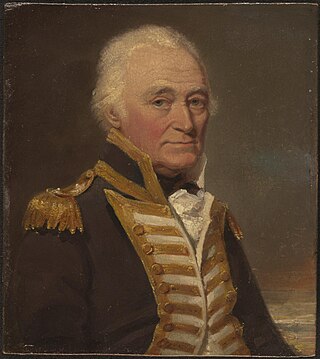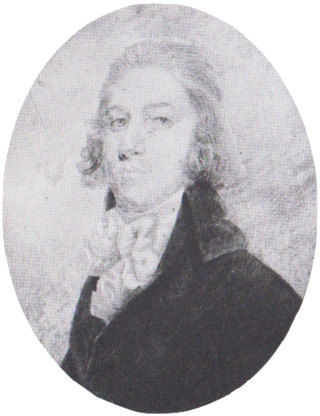
Alexander Selkirk was a Scottish privateer and Royal Navy officer who spent four years and four months as a castaway (1704–1709) after being marooned by his captain, initially at his request, on an uninhabited island in the South Pacific Ocean. He survived that ordeal but died from tropical illness years later while serving as a Lieutenant aboard HMS Weymouth off West Africa.

Admiral Arthur Phillip was a British Royal Navy officer who served as the first governor of the Colony of New South Wales.

The First Fleet was a fleet of 11 British ships that brought the first British colonists and convicts to Australia. It was made up of two Royal Navy vessels, three store ships and six convict transports. On 13 May 1787 the fleet under the command of Captain Arthur Phillip, with over 1400 people, left from Portsmouth, England and took a journey of over 24,000 kilometres (15,000 mi) and over 250 days to eventually arrive in Botany Bay, New South Wales, where a penal colony would become the first British settlement in Australia.

Vice Admiral John Hunter was an officer of the Royal Navy, who succeeded Arthur Phillip as the second Governor of New South Wales, serving from 1795 to 1800.

James Weddell was a British sailor, navigator and seal hunter who in February 1823 sailed to latitude of 74° 15′ S—a record 7.69 degrees or 532 statute miles south of the Antarctic Circle—and into a region of the Southern Ocean that later became known as the Weddell Sea.
The Second Fleet was a convoy of six ships carrying settlers, convicts and supplies to Sydney Cove, Australia in 1789. It followed the First Fleet which established European settlement in Australia in the previous year.

Lady Juliana, was launched at Whitby in 1777. She transported convicts in 1789 from England to Australia.
HMS Howe was originally the teak-built Indian mercantile vessel Kaikusroo that Admiral Edward Pellew bought in 1805 to serve as a 40-gun frigate. In 1806 the Admiralty fitted her out as a 24-gun storeship and renamed her HMS Dromedary. She made numerous trips, including one notable one to Australia when she brought out Lachlan Macquarie and his family to replace William Bligh as governor of New South Wales. Later, she became a prison hulk in Bermuda. Her most recent contribution, however, is as the source of a rich archaeological site.

Lieutenant Ralph Clark was a British officer in the Royal Marines, best known for his diary spanning the early years of British settlement in Australia, including the voyage of the First Fleet.
Albion was a full-rigged whaler built at Deptford, England, and launched in 1798. She made five whaling voyages to the seas around New South Wales and New Zealand. The government chartered her in 1803 to transport stores and cattle, to Risdon Cove on the River Derwent, Tasmania.
Peter Kenney Hibbs was an English mariner and a member of the First Fleet to Australia in 1788.

There are 20 known contemporary accounts of the First Fleet made by people sailing in the fleet, including journals and letters. The eleven ships of the fleet, carrying over 1,000 convicts, soldiers and seamen, left England on 13 May 1787 and arrived in Botany Bay between 18 and 20 January 1788 before relocating to Port Jackson to establish the first European settlement in Australia, a penal colony which became Sydney.
John Howell (1788–1863) was a Scottish inventor, who lived in Edinburgh. He was, among other things, a bookbinder, author, editor and shopkeeper. Among his more outlandish endeavors were an attempt to fly and to travel underwater in machines that he designed and built himself.
Countess of Harcourt was a two-decker, teak merchant ship launched at Prince of Wales's Island in 1811, and sold in Great Britain in 1814. An American privateer captured her in 1814, but the British recaptured her in 1815. Later, she made five trips transporting convicts to Australia. Between the third and fourth of these, she undertook a voyage to China and Nova Scotia while under charter to the British East India Company (EIC). She was wrecked in late 1830.
Castle Forbes was a merchant ship built by Robert Gibbon & Sons at Aberdeen, Scotland in 1818. She was the first vessel built at Aberdeen for the trade with India. She then made several voyages to India, sailing under a license from the British East India Company (EIC). She made two voyages transporting convicts from Ireland to Australia. She sustained damage in 1826 on a voyage to India and was condemned at the Cape of Good Hope. However, she was repaired. She was last listed in 1832, and in 1838 in Lloyd's Register (LR).
Mariner was launched at Whitby in 1807, and registered in London. Her notability comes from her having made three voyages transporting convicts to New South Wales between 1816 and 1827. She continued trading until 1857.
Lady Nugent was built at Bombay in 1813. She made four voyages under contract to the British East India Company (EIC). She then made two voyages transporting convicts to Australia, one to New South Wales and one to Van Diemen's Land (Tasmania). She also made several voyages with emigrants to New Zealand under charter to the New Zealand Company or the Canterbury Association. She foundered in May 1854 with the loss of some 400 persons, most of them soldiers that she was carrying from Madras to Rangoon.
Rambler was launched in America in 1812. The British captured her in 1813 as she was returning to America from Manila. She then briefly became a West Indiaman. In 1815 she became a whaler in the Southern Fishery. She made four complete whaling voyages and was wrecked on her fifth.
Calder was a brig launched in 1821 at Calcutta. A new owner in 1822 sailed her to Australia and she then traded in the Pacific until in 1825 she sailed to Chile and was wrecked at Valparaiso. There a new owner salvaged her and returned her to sailing under the name Indefatigable. On Indefatigable's first voyage the Chilean members of her crew mutinied, killing her captain. The mutineers sailed to Guam where the authorities took Indefatigable in prize. She was later lost in a typhoon in the China Sea.
HMS Woodlark was launched in 1808 and commissioned in 1809. The Royal Navy sold her in 1818. She then became a merchantman with her new owners retaining her name. From 1820/1821 she became a whaler, sailing out of Port Jackson. She was still sailing as late as the late 1850s.








